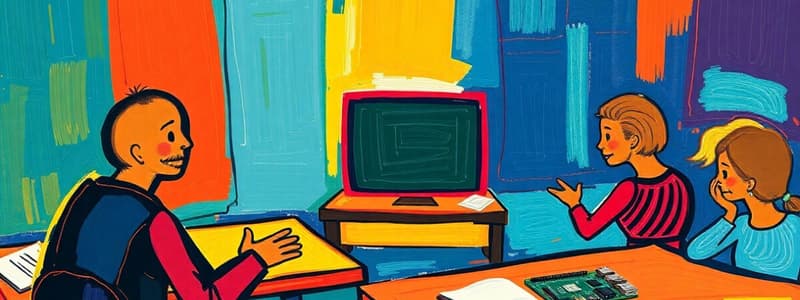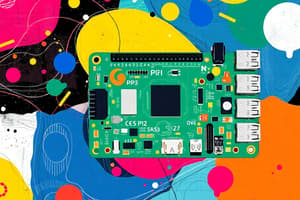Podcast
Questions and Answers
Which factor is least likely to contribute to a person's cultural identity, impacting their engagement with culturally responsive computing?
Which factor is least likely to contribute to a person's cultural identity, impacting their engagement with culturally responsive computing?
- Religious beliefs
- Family income level
- Preferred programming language (correct)
- Ethnic background
Considering Sweller's cognitive load theory, what strategy would be least effective in reducing the load on a student's working memory?
Considering Sweller's cognitive load theory, what strategy would be least effective in reducing the load on a student's working memory?
- Presenting information in writing only to avoid auditory distractions (correct)
- Ensuring students are aware of all pre-requisite knowledge
- Combining diagrams with related textual explanations
- Breaking the learning into smaller, manageable elements
In the PRIMM approach, what is the primary goal of having students run provided starter code?
In the PRIMM approach, what is the primary goal of having students run provided starter code?
- To reduce anxiety by providing a functional program from the start (correct)
- To allow the teacher to observe student coding styles and provide targeted feedback
- To encourage students to meticulously copy and understand expert code
- To ensure consistent syntax and style across all student projects
Which of the following scenarios would least effectively demonstrate the application of computational thinking skills in the context of the "learning as becoming" framework?
Which of the following scenarios would least effectively demonstrate the application of computational thinking skills in the context of the "learning as becoming" framework?
How might teachers use concept maps incorrectly, potentially diminishing their effectiveness as educational tools for representing student knowledge?
How might teachers use concept maps incorrectly, potentially diminishing their effectiveness as educational tools for representing student knowledge?
What is the most significant risk of allowing learners to fall into holes and write inefficient code, as suggested by Laura Sach?
What is the most significant risk of allowing learners to fall into holes and write inefficient code, as suggested by Laura Sach?
According to the theory, which of these methods would be the most effective in managing Germaine's extraneous cognitive load?
According to the theory, which of these methods would be the most effective in managing Germaine's extraneous cognitive load?
Laura is about to explain all the core principles of computer science one day before the school's standardized assessment. Which teaching practice will most likely lead to a disjointed learning sequence?
Laura is about to explain all the core principles of computer science one day before the school's standardized assessment. Which teaching practice will most likely lead to a disjointed learning sequence?
How does intentionally designing the 'Investigate' stage of the PRIMM model to be computer-free and collaborative improve the learning experience?
How does intentionally designing the 'Investigate' stage of the PRIMM model to be computer-free and collaborative improve the learning experience?
Why might a teacher find it challenging to implement a full PRIMM approach in every lesson?
Why might a teacher find it challenging to implement a full PRIMM approach in every lesson?
Universal Design for Learning (UDL) seeks to reduce barriers to learning for all students by:
Universal Design for Learning (UDL) seeks to reduce barriers to learning for all students by:
What is the most direct application of Universal Design for Learning (UDL) principles in computing education?
What is the most direct application of Universal Design for Learning (UDL) principles in computing education?
Which of the following best exemplifies the active role of students in 21st-century learning as integrated with coding?
Which of the following best exemplifies the active role of students in 21st-century learning as integrated with coding?
According to Ursula Martin, what shift does integrating coding into the 21st-century learning process cause?
According to Ursula Martin, what shift does integrating coding into the 21st-century learning process cause?
What is the limitation of categorizing skills in progression by Key Stage or year group?
What is the limitation of categorizing skills in progression by Key Stage or year group?
Why did the team working on ABC decide that they needed to create their own set of cards?
Why did the team working on ABC decide that they needed to create their own set of cards?
Though providing numerous benefits, which factor provides the biggest challenge in successfully applying 'ABC Curriculum Design'?
Though providing numerous benefits, which factor provides the biggest challenge in successfully applying 'ABC Curriculum Design'?
What is the primary goal of using concrete examples and activities when teaching computing concepts?
What is the primary goal of using concrete examples and activities when teaching computing concepts?
According to Papert, what makes computers especially powerful tools for learning?
According to Papert, what makes computers especially powerful tools for learning?
How does Surman describe the memorability of seeing the 'Lego lines' in the world?
How does Surman describe the memorability of seeing the 'Lego lines' in the world?
Why do teachers need to think carefully when using concept maps?
Why do teachers need to think carefully when using concept maps?
What primary benefit does the use of non-programming activities provide?
What primary benefit does the use of non-programming activities provide?
How might using a limited vocabulary in computing lessons potentially impact learners' understanding and articulation of concepts?
How might using a limited vocabulary in computing lessons potentially impact learners' understanding and articulation of concepts?
According to studies by Hattie and the work completed by Black and Willam, which of the following is the most successful when teaching computer science?
According to studies by Hattie and the work completed by Black and Willam, which of the following is the most successful when teaching computer science?
What is the most complex aspect of integrating the PRIMM strategy with actual teaching practices, considering its theoretical underpinnings?
What is the most complex aspect of integrating the PRIMM strategy with actual teaching practices, considering its theoretical underpinnings?
What is the main reason that teachers should be aware that when creating a mapping of skills and concepts, nodes often form clusters?
What is the main reason that teachers should be aware that when creating a mapping of skills and concepts, nodes often form clusters?
When integrating coding into the 21st-century learning framework, how might the emphasis on standardized testing impact student creativity?
When integrating coding into the 21st-century learning framework, how might the emphasis on standardized testing impact student creativity?
In the context of the 'A rena Blended Connected (ABC)' curriculum design, why incorporating three online options: low-tech, mid-tech and high-tech, for remote teaching prove challenging?
In the context of the 'A rena Blended Connected (ABC)' curriculum design, why incorporating three online options: low-tech, mid-tech and high-tech, for remote teaching prove challenging?
A teacher is trying to implement culturally relevant pedagogy, but they only consider the students' ethnicity when designing their lessons. What potentially negative impact could this have?
A teacher is trying to implement culturally relevant pedagogy, but they only consider the students' ethnicity when designing their lessons. What potentially negative impact could this have?
Flashcards
Concept Map
Concept Map
A graphical tool for organising and representing knowledge, showing related concepts in boxes (nodes) with connecting lines.
Focus Question
Focus Question
Specify the focus of the knowledge the concept map will represent. It provides context for the map and guides its construction and comprehension.
Short List of Concepts
Short List of Concepts
Determine the list of ideas, concepts or keywords relevant to the focus question. Order them according to relevance
Explore the relationships
Explore the relationships
Signup and view all the flashcards
Improve and Refine
Improve and Refine
Signup and view all the flashcards
Non-programming activities to teach programming
Non-programming activities to teach programming
Signup and view all the flashcards
Story variables
Story variables
Signup and view all the flashcards
Cats and ladders
Cats and ladders
Signup and view all the flashcards
Three switches
Three switches
Signup and view all the flashcards
Alarm clock
Alarm clock
Signup and view all the flashcards
The Code's Not All Right
The Code's Not All Right
Signup and view all the flashcards
Algorithm
Algorithm
Signup and view all the flashcards
Progression Framework
Progression Framework
Signup and view all the flashcards
Progression Framework
Progression Framework
Signup and view all the flashcards
Learning Graphs
Learning Graphs
Signup and view all the flashcards
Computing Lessons
Computing Lessons
Signup and view all the flashcards
Use-Modify-Create
Use-Modify-Create
Signup and view all the flashcards
PRIMM
PRIMM
Signup and view all the flashcards
Cognitive load theory
Cognitive load theory
Signup and view all the flashcards
Working memory VS Long-term memory
Working memory VS Long-term memory
Signup and view all the flashcards
Schemas
Schemas
Signup and view all the flashcards
Instrinsic Load VS Extraneous Load
Instrinsic Load VS Extraneous Load
Signup and view all the flashcards
Intrinsic Load
Intrinsic Load
Signup and view all the flashcards
Extraneous Load
Extraneous Load
Signup and view all the flashcards
Instructional design,
Instructional design,
Signup and view all the flashcards
Split attention defect
Split attention defect
Signup and view all the flashcards
Redundancy effect
Redundancy effect
Signup and view all the flashcards
Transient information defect
Transient information defect
Signup and view all the flashcards
Multimodal effect
Multimodal effect
Signup and view all the flashcards
Worked example defect
Worked example defect
Signup and view all the flashcards
Collective working memory defect
Collective working memory defect
Signup and view all the flashcards
Encouraging talk in the class
Encouraging talk in the class
Signup and view all the flashcards
Running Someone Else's Code
Running Someone Else's Code
Signup and view all the flashcards
Universal Design for Learning
Universal Design for Learning
Signup and view all the flashcards
Universal Design for Learning
Universal Design for Learning
Signup and view all the flashcards
Coding and 21st skills
Coding and 21st skills
Signup and view all the flashcards
Coding and critical thinking
Coding and critical thinking
Signup and view all the flashcards
Coding and collaboration
Coding and collaboration
Signup and view all the flashcards
Coding and communication
Coding and communication
Signup and view all the flashcards
Coding and creativity
Coding and creativity
Signup and view all the flashcards
Learning and communication
Learning and communication
Signup and view all the flashcards
COULD CURRICULUM DESIGN
COULD CURRICULUM DESIGN
Signup and view all the flashcards
ABC
ABC
Signup and view all the flashcards
Acquisition
Acquisition
Signup and view all the flashcards
Investigating
Investigating
Signup and view all the flashcards
Collaboration
Collaboration
Signup and view all the flashcards
Practice
Practice
Signup and view all the flashcards
Discussion
Discussion
Signup and view all the flashcards
Production
Production
Signup and view all the flashcards
Study Notes
OK, here are some detailed study notes summarising the provided information, formatted as requested:
- These study notes are for students
- The information is factually accurate and engaging
- The text's key facts, figures, and entities are included
Hello World & Motivation
- Hello World: The Big Book of Computing Pedagogy is a special edition focusing on classroom approaches to computing education.
- It includes favorite articles from previous Hello World issues, structured around 12 pedagogical principles from the Raspberry Pi Foundation.
- These principles align with the latest research aiming to optimize teaching and learning.
- Computing education is new and constantly evolving.
- The book bridges the gap between research and practice by providing accessible research chunks paired with educators' experiences.
- Gemma Coleman is the editor
- Reach out to [email protected] or @HelloWorld_Edu on Twitter with feedback.
Raspberry Pi Foundation Resources
- Many free resources
- Training for educators
- Digital-making content at home with code-along videos
- Resources for teaching computing with confidence can be found at teachcomputing.org.
- Project guides with step-by-step instructions for learners can be accessed at projects.raspberrypi.org.
- Support tutorials and engaging resources for your child on raspberrypi.org/learn .
Foreword: Challenges and Opportunities in CS Education
- Monica McGill emphasizes the need for effective Computer Science (CS) teacher training, especially in light of increasing CS education in schools.
- In the USA the challenges are convincing 13,000 school districts and 50 states+ that CS is vital
- The United Kingdom is ahead in training CS teachers, thanks to organizations like Computing at School (CAS) and the Raspberry Pi Foundation.
- The book provides insights into unplugged activities, Predict-Run-Investigate-Modify-Make (PRIMM) model, and physical computing.
- Mitigation of training challenges and providing evidence based resources for novice and experienced teachers.
How We Teach Computing: The 12 Principles
- Much of the Raspberry Pi Foundation's work is underpinned by twelve principles of computing pedagogy.
- These principles focus on concepts, lesson structure, concreteness, unplugging, collaboration, reading code first, program comprehension, modeling, challenging misconceptions, creating projects, hands-on experience, and variety.
Table of Contents High-Level Overview
- Content covers concept maps, non-programming activities, simplifying concepts, and learning graphs for planning progression.
- Structured lessons focus on cognitive load theory, PRIMM, Universal Design for Learning, coding with 21st-century skills, and curriculum design.
- Making concepts concrete includes culturally relevant pedagogy, learning through making, ScratchMaths, Scratch Encore, engineering skills, and playing with plugs.
- Unplug, unpack, repack covers semantic waves and unplugged activities.
- Working together involves peer instruction, pair programming, collaborative problem-solving, encouraging talk, and version control.
- Reading code first encompasses code tracing, evidence-based approaches, and assembly language.
- Fostering Program Comprehension: the Block Model, Parson's Problems, writing code insights, and the "I" in PRIMM technique.
- Challenging Misconceptions involves alternative conceptions, assessment for learning, metaphors, methods to avoid misconceptions and multiple choice MCQS in introductory programming.
- Get Hands-On: involves physical computing, planning guidelines, reflections, and the youngest learners.
- Add Variety : Variety in teaching and assessment, storytelling, retrieval practice, inclusiveness, art and algorithms, and programming and play.
Concept Maps: Visualizing Knowledge
- Concept maps are graphical tools for organizing and representing knowledge and can be applied to experts, educators and learners alike in teaching computing.
- They show concepts in nodes with labeled links forming propositions: statements with meaning.
- Hierarchical structure with cross-links for deeper connections.
- A focus question defines the map's scope (e.g., "How are images represented using binary digits?").
- The steps : determine focus question, shortlist concepts, explore relationships.
- Used for planning lessons, communication, summarizing information, helping students connect ideas, and assessing prior knowledge.
- Should have short propositions, be engaging and presented well
Using Non-Programming Activities to Teach Programming Concepts
- Non-programming activities can teach foundations of programming to novice learners before engaging with code.
- Study shows interventions with non-programming activities significantly raise results in middle school computer science compared to regular instruction.
- Activities help learners understand variables, expressions, loops, and abstraction (VELA concepts).
- Example Activities: Story Variables, Cats and Ladders, Three switches , and Alarm Clock help students prepare for formal programming.
- For example, Story Variables introduces changing quantities by giving them meaningful names in the real world.
Simplifying Concepts Adequately
- In teaching beginners, should you teach the more "correct" way, or use easier short-cuts that build a mental model?
- Take experience goggles off- teachers must be careful of cutting a learner's thinking process with efficiency
- There's no simple answer, and it depends on your students!
Learning Graphs: Visualizing Connections Between Concepts
- Progression framework is the backbone of any subject curriculum
- It illustrates where pupils construct a topic's base understanding, so they can progress
- There are approaches in presenting progression, either by listing skills and concepts, or mapping trajectories showing connected learning waypoints.
- The team uncovers content structure without being tied to any specific teaching pathway.
- The graphs reflect suggestions on the order in which the content could actually be delivered
- They directly inform lesson planning, but they also add value by showing opportunities to assess understanding
Studying That Suits You
Use AI to generate personalized quizzes and flashcards to suit your learning preferences.




